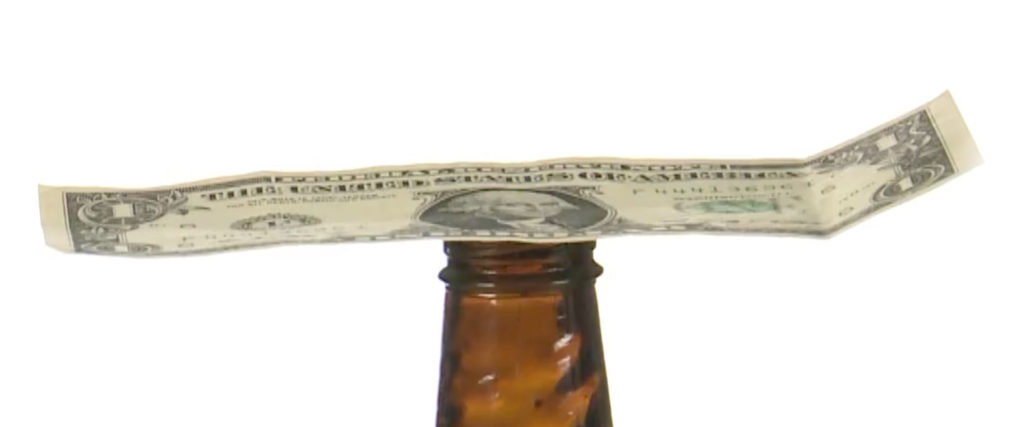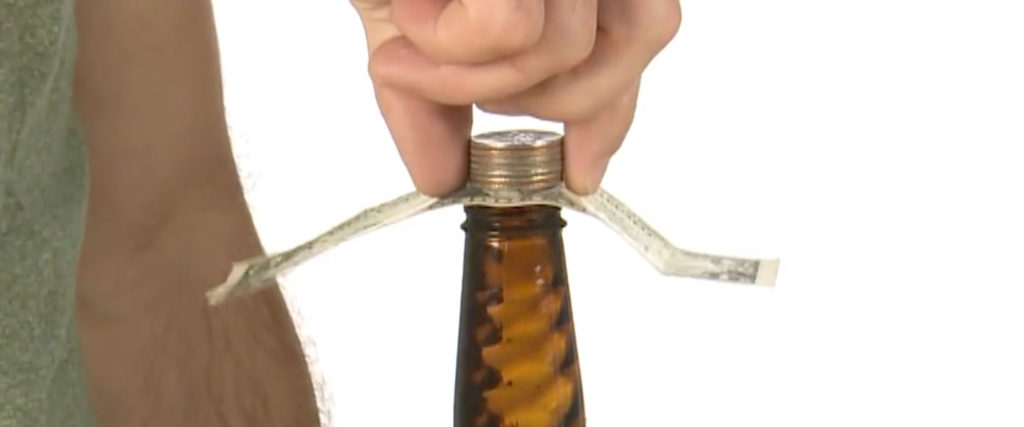Inertia Ring
The object of this activity is to get the hex nut to drop into the plastic bottle. Simple enough but there will be something in the […]

Sometimes a science demonstration based on inertia comes off as a “trick” to some people. Some of these tricks drop eggs into water and others have you whipping a tablecloth out from under some dishes. Dollar Bill Inertia Challenge is another fantastic demonstration of inertia which is the centerpiece in Newton’s First Law of Motion. You might even earn a few bucks if people are willing to put their money where their skeptical mouth is. It’s a side benefit to you for knowing the science.

Place the paper currency on the mouth of a soda bottle. (Use plastic bottles to practice but glass bottles are a better bet for the real thing.) The bill can be centered right over the opening or offset a little so one side is a bit longer than the other.

Place the stack of coins (six or so) on top of the bill so they’re directly over the mouth of the bottle.

Point an index finger and use it to quickly “karate chop” the dollar bill between the bottle and the quarters. Don’t hit either the coins or the bottle with your finger.
If the currency is limp and droops, have your skeptical participant hold it horizontally.
You could offer “double or nothing” odds for the next outcome. Instead of coins, place the other bottle on top so it’s mouth-to-mouth with the first bottle and the currency is sandwiched in between. Strike the bill as before and the bottles stay in place while you collect your winnings!
The key to the Newton’s Bottle activity is inertia. Sir Isaac Newton’s First Law of Motion states that inertia is the tendency of an object already at rest, to remain at rest. If an outside force is strong enough and acts on it, however, then the object’s inertia is overcome and it moves. Inertia is important in the Newton’s Bottle trick because the coins and the bottle (the objects) aren’t moving and won’t move unless an outside force (like your chopping finger) moves them.
Friction plays a very important role in this demonstration as well. Friction is the tendency of one surface to resist or grab or cling to another surface moving across it. This resistance can generate a lot of heat, too (rub your hands together quickly). The surface of the bill (especially a newer one) is clean and smooth. It doesn’t create a lot of friction against the stack of coins above it or the bottle below it. Without this friction, the bill doesn’t pull the coins (or move the bottle) and they remain balanced on their glassy perch. All bets are off if you use something like sandpaper or a tacky paper instead of newer currency, however.
Knowing what you do about inertia, test the bill in between other identical objects stacked on top of each other.
Snapping bills out between two stacked objects is a pretty cool activity but it’s not a science fair project. You create a science fair project by identifying and testing variables. A variable is something that might change the outcome. Let’s take a look at some of the variable options you might test and write up for a science fair.
These are just a couple of ideas and you certainly aren’t limited to them! Come up with your own variable to test. Remember, you can change only one variable for each test while making sure that all the other factors in your test remain the same!
It should be pretty obvious that practicing with plastic objects stacked on top of each other is a lot safer than starting out with glass objects. Also keep in mind that objects with more mass (weight) will hurt a lot more if your toes come between them and the floor if they fall.